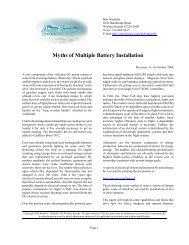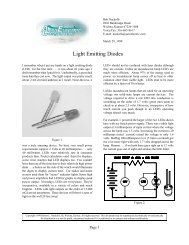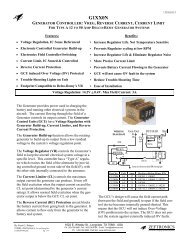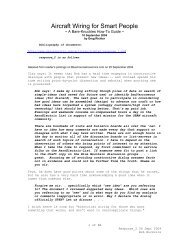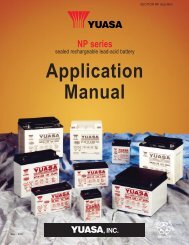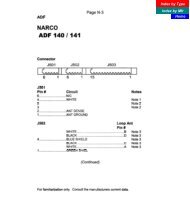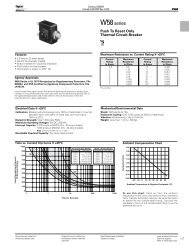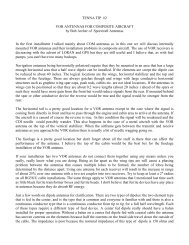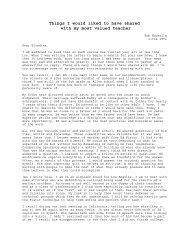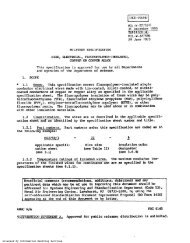Spikes and Transient Voltage Suppressors - AeroElectric Connection
Spikes and Transient Voltage Suppressors - AeroElectric Connection
Spikes and Transient Voltage Suppressors - AeroElectric Connection
You also want an ePaper? Increase the reach of your titles
YUMPU automatically turns print PDFs into web optimized ePapers that Google loves.
Figure 1. Current versus Time to Trip Klixon Miniature Breaker.Figure 3. Max Power vs. Pulse Widthfor 1.5KW Transorb.Figure 2. Incremental <strong>Voltage</strong> Values for 1.5KW Transorbs.crank the engine? By then, it's been useless as eitherguardian of the bus -OR- st<strong>and</strong>by power for too long.Turning loads like l<strong>and</strong>ing lights on <strong>and</strong> off producesmaller transients that may be a problem depending onthe electrical bus design <strong>and</strong> wire length <strong>and</strong> size. TheCopyright © 1998 by Robert L. Nuckolls, Wichita, Kansas. This document may be reproduced mechanically or electronically for non-profit, educationalpurposes when produced in its entirety <strong>and</strong> without modification. Fair use excerpts for critical review welcomed.3
peak voltages can exceed 100 volts. This may be aproblem when the source is on the same electrical bus asother sensitive components <strong>and</strong> the battery is electricallysome distance away.Yes, the bus is noisy, it jumps around a bit every timesomething is switched off or on . . . but so what? Yes,there is some "inductance" in the wiring that can storeenergy <strong>and</strong> reduce the ability of the battery to filter . .. but the 100 volt figure is pure fiction under thedescribed scenario (more on this later).While not a voltage spike the accidental reversal of thebattery leads or the miswiring of power to a expensiveinstrument or avionics box can result in instant <strong>and</strong>expensive damage. The same $1 device also protectsagainst this human error.If one is really worried about this event, a simple diodein series with the master switch coil lead prevents themaster switch from being closed with areverse-connected battery.====================On 4-2-98 he responds <strong>and</strong> I offer further comments .. . .Perhaps you missed the Kitfox alternator failure whereyour regulator was installed <strong>and</strong> the later string offailures that destroyed thous<strong>and</strong>s of dollars of electronicswith a transient with a good battery installed. Clearly thisset of electronics needed better protection.I believe you're referring to Peter G.'s experienceflying to Sun-n-Fun last year. Re-reading his post ofMarch 11th I've confirmed my recollection that hestarted out with an LR3 regulator <strong>and</strong> a non-B&Calternator suitably modified for compatibility with theLR3. An alternator failure enroute promptedreplacement of the whole system with an alternatorhaving a built-in regulator <strong>and</strong> an OV protectionsystem that I'm not familiar with. No B&C hardwarewas installed when the system smoked his radios.If you're speaking about another airplane, I'm notaware of it <strong>and</strong> would appreciate knowing who theowner is.Your lack of experience in load dump <strong>and</strong> other transientsis not relevant to their universally recognized presence<strong>and</strong> the automotive industry spends millions each year inprotecting equipment from them.I apologize for hoof-in-mouth with reference to myearlier words about "load dump". I see that theautomotive vernacular for the phenomenon is differentthan the aviation meaning. They do indeed speak ofbattery disconnect while the battery is simultaneouslybeing a large "load" on the alternator. I'll suggest thisis a poor choice of words because it muddies the waterfor other equally valid definitions of "load dump" usedfor years in the airplane business.Your words supporting the use of Transorbs on everypotential victim appear to be almost verbatim from theHarris Semiconductor section on <strong>Transient</strong> <strong>Voltage</strong><strong>Suppressors</strong>. How does this document drive a notion of"universal recognition?" Is this document the Bible? Isit to be read <strong>and</strong> all words acted upon because we havefaith?But back to my point. The Harris TVS data describean "Inductive Load Switching <strong>Transient</strong>" havingamplitudes of -300 to +80 volts, a duration of up to 320milliseconds <strong>and</strong> released energy of less than 1 Joule.Inductively stored energy is retained according toj=(L*I^2)/2. Assume a 10A load <strong>and</strong> work itbackwards for a 1 Joule dump. I compute that thenecessary inductance is 20 millihenries. Given thatwire inductance is measured in nanohenries per foot,I have trouble visualizing a l<strong>and</strong>ing light or pitot heatercircuit that's going to store even a tiny fraction of 1Joule.When the hypothetical load is shut off, where does thestored energy go? Most of it is lost in heating up theairgap between contacts of the switching deviceleaving little to go anywhere else. What about otherassertions made in the Harris App Note? I have toassume there ARE some devices on cars that havehigher energy storage abilities . . . perhaps door locksolenoids? Power seats? I don't KNOW <strong>and</strong> it doesn'tmatter. I'm working on airplanes. How does theapplication note apply to what we're doing? I'll suggestit's unclear without the kind of analysis I've asked youto participate in <strong>and</strong> have demonstrated. Further, ifthe astute system designer has identified a hazard,doesn't it make more sense to (1) clamp off hazardousenergy at the SOURCE <strong>and</strong>/or (2) quantify the abilityof victims to tolerate the antagonist than put a blanketof b<strong>and</strong>-aids on every potential victim <strong>and</strong> hope we'vedone a good thing?The Transorbs would have protected the electronics Thiswould have limited the damage to $1 plus the time to fixthe problem.Copyright © 1998 by Robert L. Nuckolls, Wichita, Kansas. This document may be reproduced mechanically or electronically for non-profit, educationalpurposes when produced in its entirety <strong>and</strong> without modification. Fair use excerpts for critical review welcomed.4
Agreed . . . in the Peter G. case I've cited, yourproposed effect would have been achieved . . . but aproperly architectured alternator system would havedone as well with a whole lot less fuss.Further with 5-10 of these Transorbs in the system themain "fuse" (yes I agree there should be a fuse in thiscase!) would have blown under the combined load of250-500 amps.Where's this 250-500 amp source? How does analternator deliver at any greater current than it'smagnetically limited design? How does a batterydeliver energy to the Transorbs at a voltage above it'schemistry limits?You jumped to the conclusion that the specified Transorbwould fail before the CB opened. You jumped to theconclusion that I was full of BS <strong>and</strong> did not do analysis<strong>and</strong> testing to prove what I said. I have done both <strong>and</strong> notonly does the Transorb blow the circuit breaker withoutdamage but 5 cycles in 10 seconds resulted in no damage<strong>and</strong> the Transorb barely got warm. Even if it failed shortit did the job of protection that multi thous<strong>and</strong> dollaravionics package. How you can say no to such an simplesolution that is widely recognized as a fix to a realproblem mystifies me.Okay, let's look at the data sheets from which myconclusion was launched: Figure 1 is the reaction timefor the Klixon miniature breakers. Note that a 5 ampbreaker will clear 50 amps in 50-500 milliseconds.Figure 2 shows incremental clamping voltage versuscurrent for a typical 1.5KW Transorb while Figure 3describes power dissipation ratings versus time .Figure 2 sez that an 18V, 1.5KW Transorb willincrement approx 1 volt at 50 amps. So, 50 amps times19 volts is 950 watts. The curve tells us the device willst<strong>and</strong> off 950 watts for 3-4 milliseconds. The operatingtime for a Klixon 5A breaker is about 10X this value.Am I reading this data incorrectly? Have you locateda 5A breaker that will clear 50A in less than 10milliseconds? If so, do you expect every breaker toopen this fast?Further, during OV runaway "load dump" overshoot<strong>and</strong> alternator does not become endowed with anygreater ability to deliver current. Therefore, I'llsuggest the 50A pulse per Transorb you postulatewould occur if <strong>and</strong> only if there is but one Transorb inthe system.Let's install, six 1.5KW, 18V Transorbs in ourhypothetical airplane. Let's assume the mostlydischarged battery disconnect ("load dump") occurs<strong>and</strong> the bus voltage climbs. As the Transorbs begin toclamp off the voltage rise, our 60-amp alternator willtransition into current limit; it's total output will bedistributed over the 6 Transorbs <strong>and</strong> what ever loadsare already present on the system. AssumingPERFECT paralleling <strong>and</strong> no system loads, eachTransorb might see about 10 amps or 180W. Figure 3suggests that a 180 watt surge can be h<strong>and</strong>led forabout 400 milliseconds. How long does it take for theKlixon 5 amp breaker to open with 10A load? Figure1 says between 2 <strong>and</strong> 20 seconds.I suspect at least one Transorb will be toast.Interestingly enough, when the first Transorb shorts,it's clamping voltage drops from 18 to zero. If there'sno battery on line to support the fault current throughthe failed Transorb, then alternator field excitation willbe immediately lost; the alternator relaxes <strong>and</strong> thewhole system simply shuts down. In a 14 volt system,OV protection generally disconnects the alternator at16-17 volts <strong>and</strong> in less than 50 milliseconds from onsetof the event . . . faster than the Klixon upstream of atormented Transorb can trip.If a "lost battery" load dump precipitates the event,then crowbar OV protection will stall the system aseffectively as the shorted Transorb did. On the otherh<strong>and</strong>, if it's a true OV condition brought on by a failedregulator, then the BATTERY is in place to providethe typical 200-300 amps of fault current that opens thefield breaker in under 10 milliseconds after the SCRtrips.Why is it preferable to buckshot a system withTransorbs to protect against a few, easily identifiedantagonists as opposed to (1) knowing who theantagonists are, (2) doing the analysis to show that thepotential for harm is real, (3) designing the system toeliminate the hazard with the lowest parts count <strong>and</strong>potential for maintenance, <strong>and</strong>/or (4) using components<strong>and</strong> appliances that are clearly designed to be happy inour airplanes?Or the example of the radio currently being sold that has18v max parts in the power input circuit with no realprotection. I gave you a specific make <strong>and</strong> model <strong>and</strong>never got a response from you.I'd sincerely appreciate a repost on the data. I'd liketo speak to the manufacturer. Things do fall intoCopyright © 1998 by Robert L. Nuckolls, Wichita, Kansas. This document may be reproduced mechanically or electronically for non-profit, educationalpurposes when produced in its entirety <strong>and</strong> without modification. Fair use excerpts for critical review welcomed.5
cracks around here . . . I sift through 200-300 pieces ofe-mail a day . . . .Bob you fill a needed nitch in aviation <strong>and</strong> you are a realasset. That does not mean you are always correct <strong>and</strong>clearly there is more than your solution to a problem. Youmight find more who question your positions if yourresponse was not so overwhelming.Overwhelming? Gee, have you never stood in front of10-20 other engineers in a critical design review? I'monly one voice. You oughta come work where I do . . ..Why should I have to prove my point. You should supplythe factual detailed data to support your point.manufacturers defy all logic". I'll suggest there is a lotof logic that will have to be shot down with more thanout-of-context quotations from a transient voltagesuppressor data book. Show me da numbers.Some folk have asked me, "Does it hurt to install allthe suggested Transorbs? Seems they're not going todamage anything <strong>and</strong> they might do some good. Whyall the fuss?" Fair questions.First, how should a builder install these things?Transorbs look like a fat, plastic diode with SOLIDwire leads designed to be soldered to etched circuitboards. You need both power <strong>and</strong> ground leads towire up the device so I suppose I would do this:Okay, just did . . .Your article on LEDs implies a lack of underst<strong>and</strong>ing ofwhat the manufacturer means by max ratings.On the contrary, it nicely illustrates my point aboutlatching onto the anybody's data sheets <strong>and</strong> preachingthem as gospel applicable to every situation without areality check. The TVS data is well intentioned <strong>and</strong>appropriate for some design environment. Ourenvironment? How do we know without deducingwhich device(s) offer potential hazards <strong>and</strong> devisingthe best way to deal with them? I was asking you forinformation specific to our airplanes that confirms theneed for extra-ordinary action of installing TVS deviceson any much less all potential victims. Wouldn't it bebetter to identify the antagonist <strong>and</strong> control it at thesource than to sprinkle prophylactic measures aboutthe airplane?And cover it with heatshrink like this:I feel you need to apologize to me for your ill thought outtrashing of my comments. I will not respond to this (publicor private) in any way as it is not worth my time so dowhat you want.Not worth your time to be an engineer? Doesn't itmake a difference that potential victims of electrogremlinsin aviation are/should be qualified toDO-160? I am sorry if your feelings are hurt, <strong>and</strong> I'llnot dwell on how much disinformation you recentlydisseminated about me, my products <strong>and</strong> my writings.This isn't religion or a popularity contest. It isscience. I'm asking you to be an engineer, not apreacher of anybody's gospel . You started this threadwith a pronouncement that, "the actions of avionicsHow would you recommend that 5-10 such devices beinstalled? I see no graceful way to install these thingsoutside a product to be protected."Salting" the system with the proposed prophylaxisagainst spikes is (1) a confession of our inability tocontrol problems with analysis <strong>and</strong> design <strong>and</strong>/or (2) anexpression of distrust of supplier ability <strong>and</strong>responsibility to design products worthy of the moneythey ask. You say you've found a product with an 18vCopyright © 1998 by Robert L. Nuckolls, Wichita, Kansas. This document may be reproduced mechanically or electronically for non-profit, educationalpurposes when produced in its entirety <strong>and</strong> without modification. Fair use excerpts for critical review welcomed.6
not-to-exceed device tied right to the bus. What's ourresponsibility as knowledgeable consumers? Should wewillingly install b<strong>and</strong>-aids on the system in acceptanceof poor craftsmanship <strong>and</strong> design? I'd prefer to sendthe thing back <strong>and</strong> make the turkey do his homework.People are spending a lot of dollars, time <strong>and</strong> effort todo the best job the current technology <strong>and</strong> state of theart will allow. Shotguned "protective" measures asyou've proposed do nothing to advance the art <strong>and</strong> mayin fact encourage careless work by manufacturers.We wouldn't tolerate sloppy designs on our cars <strong>and</strong>stereos, why encourage it in our airplanes? In anothercontext on the same machines: Suppose you weresuspicious of the qualification of a wing attach bolt.Would you confirm the installation of the right bolt orjust wrap the joint with plenty of baling wire?Copyright © 1998 by Robert L. Nuckolls, Wichita, Kansas. This document may be reproduced mechanically or electronically for non-profit, educationalpurposes when produced in its entirety <strong>and</strong> without modification. Fair use excerpts for critical review welcomed.7


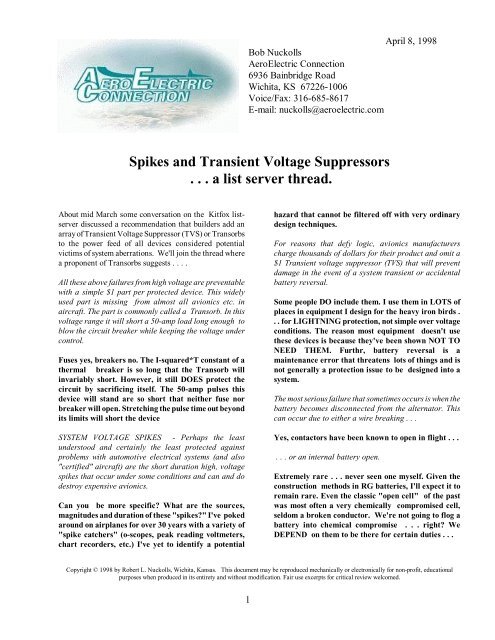
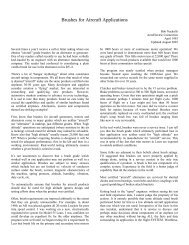
![G-Series-Ext [pdf] - Carling Technologies](https://img.yumpu.com/50918301/1/190x245/g-series-ext-pdf-carling-technologies.jpg?quality=85)

